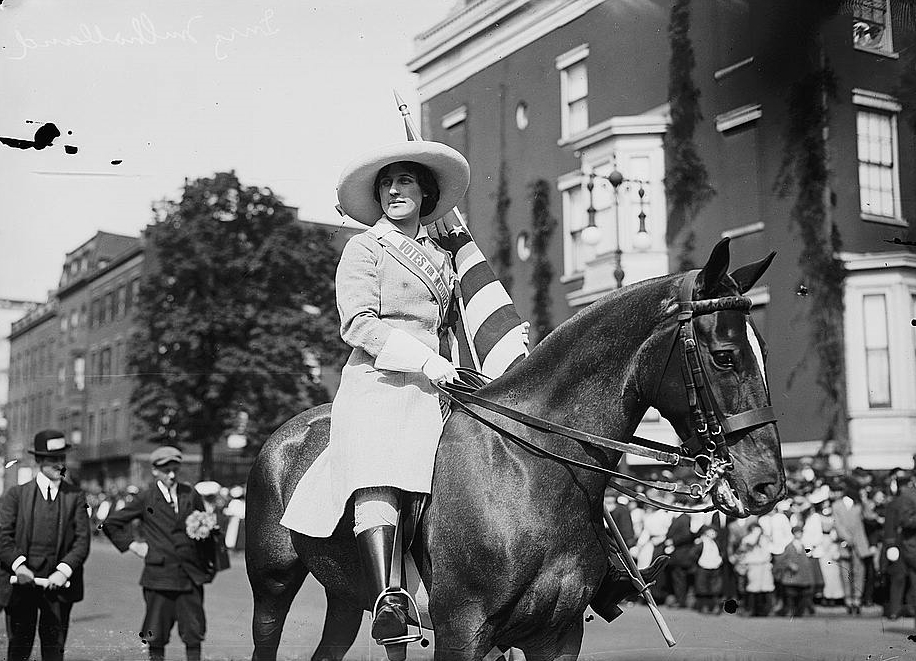
Inez Milholland Boissevain at a women’s suffrage parade in New York City, May 3, 1913.
Birth Date: August 6, 1886
Death Date: November 25, 1916
Location: Lewis, New York
Monument Type: Historic/Residence
In 1886, Inez entered the world as the firstborn child of John Milholland and Jean Torry Milholland. Two more children, Vida and John, joined the family after Inez. Her parents instilled in Inez a drive to transform the world around her. Inez went to the Comstock School, an institution in New York, as a young girl. As a teen, the Kensington High School for Girls, located in London, England, helped establish the foundation for Inez’s activism. Germany also provided a place for Inez to dive into learning, as her intellect grew in the Willard School for Girls. For her undergraduate studies, Inez went to Vassar College, one of the leading U.S. women’s colleges, in Poughkeepsie, New York. She exuded athleticism, performed in theater productions, and engaged in politics during her college years. The college administration would not allow gatherings about women’s voting rights at Vassar’s campus. Inez responded by using another venue: the local graveyard. The press took notice, as the New York Times called Inez “an ardent suffragist” in June 1908. The fight for women’s suffrage on the other side of the Atlantic Ocean had galvanized Inez to spread that fire. Inez immersed herself in suffrage activism when abroad in England. She kept pushing for political change during her life subsequent to the noteworthy Vassar days, such as involving herself with the struggle of shirtwaist strikers in New York City. Inez’s actions went deep, as police arrested her. Yet Inez’s socioeconomic class gave her privileges out of reach to many arrested women. Inez pressed on in education as well, as she went to New York University to get her law degree.
Journalists wrote about Inez, especially her activities for women’s suffrage. The media deemed her “the most beautiful suffragette.” Inez’s enchanting role in the March 1913 suffrage march in Washington, D.C., catapulted her to further stardom. Pictures of the stunning activist atop a majestic horse spearheading the procession spread in the media. In May 1913, Inez participated in another major suffrage procession. Like she had in the nation’s capital, she excelled at the march in New York City.
As she radiated charisma, Inez took on prominent lovers during her short time in the world. She married Eugen Boissevain a few months after she had dazzled in the legendary march in the U.S. capital. Yet marrying the businessman did not dampen Inez’s enthusiasm for activism. She worked in journalism, and she persevered with fighting for women’s voting rights. With the movement growing, Inez launched a massive U.S. speaking campaign. Inez, traveling from place to place during autumn 1916, worked at an arduous pace. In October 1916, in the middle of a speaking engagement in California, Inez collapsed; even though she captivated those in attendance for her events, Inez had been unwell throughout the campaign. Inez was hospitalized, and she passed away in late November 1916. Inez’s death astonished and motivated those working for women’s voting rights. As Inez brought charisma to the quest for women’s right to the ballot box, perishing at only thirty years old further made her into an icon representing “Joan of Arc” in the crusade.
Sources
“Last Call Answered by Inez Boissevain.” The Atlanta Constitution. November 27, 1916, 1.
Lumsden, Linda J. Inez: The Life and Times of Inez Milholland. Bloomington: Indiana University Press, 2004.
Nicolosi, Ann Marie. “‘The Most Beautiful Suffragette’: Inez Milholland and the Political Currency of Beauty.” Journal of the Gilded Age and Progressive Era 6, no. 3 (July 2007): 286-309.
“Vassar’s Head Indignant.” New York Times. June 10, 1908, 7.
